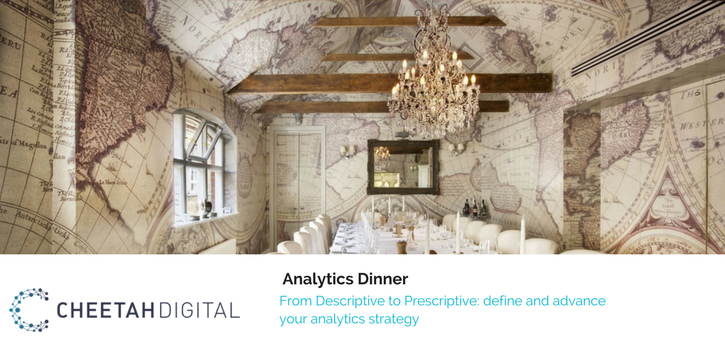The Analytics Dinner took place on 14 March 2018 at the Mews of Mayfair. It was held in partnership with Cheetah Digital, with the goal of discussing and understanding what makes a successful analytics strategy.
Cheetah Digital is about speed; the idea is to empower marketers by taking the relevant customer data to their fingertips. They were therefore well placed to provide expertise about data analytics strategy.
Conversation topics included:
- How can you analyse and assess your position on the analytics sophistication curve?
- Identifying the right questions for maximum insight: what do you really need to know?
- Developing a successful analytics strategy: what works, and what are your competitors doing?
- Building a data-driven culture: how do you bring your organisation and team with you?
Building Bridges
‘Digital Revolution’ is a term that has been bandied about, with an emphasis on how new technologies can lower costs and increase convenience. Less attention, however, has been paid to what challenges have come from this new technological era; specifically in the context of big data. There’s no doubt that businesses now have more access to data than ever before, but how do you make sure you’re getting the most out of it?
A recurring theme of the discussion focused on the traditional layout of most organisations. This generally consists of separate teams, each with their own priorities and aims, and often with little communication or collaboration.
One member compared data analytics and marketing to separate islands; each isolated and untouchable from the other, with their own language and customs.
For companies to succeed in this new digital age, a bridge must be built between the two islands. Marketers must have some knowledge of analytics and vice versa so that the two teams can speak the same language and engage with one another.
Data and creativity Insights from data need to be combined so that both the creative and analytical wings of marketing can create a better customer experience. When data is actively shared, it can be used to back up any decision made within the organisation.
One guest cited the Ben Franklin effect; referring to his ability to improve his relationship with a fellow legislator who disliked him. Franklin asked him, and later thanked him, for a favour, significantly improving their relationship. In the business world, this translates to one individual being more likely to do a favour for an individual if they have already performed a favour for that individual. Employees should not be afraid to ask one another for help or suggestions.
Leaders should also be open to asking their employees for information or advice on what they’re working on as showing vulnerability could be a good way to earn trust . By creating these bridges you ensure you’re getting the most out of your data by allowing it to be approached from different angles.
How to Make Data Accessible
Information overload seems to be a common trend, with many businesses asking themselves, “I have all this data, now what?” There needs to be a game-plan regarding how to organise and structure your data so that key information can be extracted when you need it. A strategy must be in place to ‘future proof’ your data to ensure it is stored in a way where it can be used later.
While it may be hard to predict when and why one will need certain aspects of the data, a strategy needs to be in place to make this as easy as possible. Structuring in this way will also allow companies to scale more effectively as you can immediately access the information you would need to start new projects.
In conjunction with this, individuals must feel empowered so that every member of an organisation can get the right data whenever they need it. There needs to be a push to make data reusable and available outside the domain of just analytics so that it can be used by every member of the team, instead of only relying on reports from data analytics. With this, there should be a move towards greater collaboration and sharing, allowing every member of the team to share their failure and success stories with the rest of the organisation.
Moving Towards a Data Driven Culture
To get the most out of data in the future, there needs to be a shift in leadership mentality. CEOs and other senior individuals need to make sure that every decision is being made and supported with data, within the context of larger business goals. There also needs to be change in training employees internally so that there is more fluidity within roles.
Traditionally, teams have been siloed from one another, with an analyst acting only as an analyst and a marketer doing only marketing. There should be a blurring of these roles so that you have multi-skilled employees within different disciplines. Albeit, experts are still needed; but on a base level, leaders should encourage individuals to act on those opportunities in which they can develop different skill-sets.
There should also be a drive towards creating cross-functional teams, with an analyst, marketer, technologist, HR rep, etc all coming together around a specific issue. This will ensure that key people are using their insights to make driven decisions.
A data driven culture also implies every employee is on board and can see the value of proper data collection and sharing. Leaders should be explicit in providing clear definitions of what CRM is and how it saves time and cut down costs. Shrewd examples of data success stories should be readily shared so it is clear how it can make a specific individual’s job easier.
Moving towards a data-driven culture is similar to a flywheel; the first turn of the wheel is incredibly difficult, but with every additional spin it gains momentum and speed.





Leave a Comment